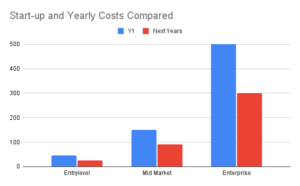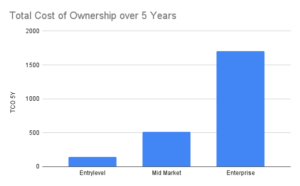The costs or PIM are key to any selection and implementation project. That makes the following one of the most asked questions of the PIM industry and it is not related to products or data at all: “how much does a PIM Cost?”
It’s the shortest answer and probably the one most system integrators or vendors will give you. We have written an extensive article on the drivers of PIM Costs (and how we incorporate them into our Cost Calculator), but we can summarize them into three key factors:
PIM Costs Driver: Complexity
Higher complexity usually leads to higher costs, both during the implementation and setup of your solution as well as in-licensing: your requirements might simply not be met by the less sophisticated solutions in the market. Since it is a vague term, we have broken it down into:
1a. Product Complexity
Drivers that make your products more complex. Examples include:
- Complicated attributes: such as calculated attributes, attribute transformation or required specifications such as ETIM classification structures
- Complicated structures: large, overlapping hierarchies and categories
- Complicated relationships: multiple upsells, sets, spare parts per product, based on attributes
- Complicated content: a large amount of text, images, videos, .pdfs, per product and in multiple languages
These drivers all interact to create more complex requirements and thus (often) higher costs.
1b. Organizational Complexity
Another driver for complexity is organizational requirements. These include but are not limited to:
- Process rigidity: the less flexible your organization and its processes are, the more rework and customization need to be done
- Many input sources: more sources (suppliers, data pools, internal teams) for product data means more conflicts, complexity, and therefore costs.
- Many output channels: all marketplaces, syndicators, and marketing channels have specific requirements that often need to be customized.
- Multiple business units: leveraging the same product catalog over multiple (multi-national) business units increases complexity
Questions? Schedule a free call with a PIM specialist
Find out how we can help you with any Product Information Management issue.
Schedule a free callPIM Costs Driver:Quantity
It might sound obvious, but the more products, relations, content, and people need to be covered in a PIM, the higher the costs. This is both because of the actual storage, bandwidth and server costs associated with managing a larger product database and also because of the difficulty in keeping a PIM running smoothly with this number of products.
But not all PIM systems are created equal and often the solutions with the bigger development budgets (and higher costs) are better able to smoothly handle large product catalogs.
This starts to matter if you have more than 100.000 products, so if you manage less than that you are often not so much affected by performance limitations.
PIM Costs Driver: IT Readiness
Though it does not directly impact your solution choice (the complexity and quantity are the main drivers for picking a solution that fits your requirements), the IT readiness of your organization is the deciding factor in determining the design and implementation costs for your PIM Solution.
Implementation costs are your biggest costs in the first year(s) of using a solution and can be up to 50% of the total cost of ownership of a PIM. But how to determine your IT readiness? We have identified two key drivers:
Architecture: how ‘mature’ is your IT architecture? Is everything in place and is the PIM solution the only addition? Or is it part of a major overhaul of your IT architecture? Is there a blueprint of the future architecture available? Or are we starting from scratch? Depending on your answers a lot of pre-work might be necessary before you kickstart the actual PIM project.
Knowledge Level: what is the internal knowledge level on data and PIM processes? Are key processes (product creation, enrichment, output) clearly defined and ready to be implemented? Are teams already working with dedicated PIM tools or do they need additional training?
The more (consulting and training) work necessary, the higher the implementation costs. Still: it’s better to invest in “getting the basics right” than choosing the wrong PIM (or implementing it the wrong way) and having to throw away a half-finished implementation after 6 to 18 months.
Entry-level vs Enterprise: costs compared
Even though it does not lead to a specific cost estimate, you might have a general feel for which category PIM you might consider.
We’ve divided them into three categories:
- Entry Level: solutions fit for start-ups and scale-ups and small businesses
- Mid-Market: solutions for larger organizations or for businesses with more complex product needs or with a higher organizational complexity
- Enterprise: solutions for large organizations with extensive product catalogues and deep organizational complexity
Since PIM costs are often skewed towards the first year (because of the extra design and implementation costs), we will list both “year 1” and follow-up year costs of the categories above:
Entry Level:
Y1: € 20-70k
Next years: € 10-40k
Mid-Market:
Y1: € 50-250k
Next years: € 30-150k
Enterprise:
Y1: 200k-1mln
Next years: 100-600k
Or if we compare them graphically:

In the enterprise category, the range is especially broad as this includes both local category leaders as well as huge multinationals. Still, when we compare costs and look at a total cost of ownership over 5 years (which is rather short, we usually see PIMs being replaced after 5-10 years) you get the following comparison:

Which system are you considering?
We have classified all our Solution Partners in the three categories mentioned above. On their partner page, you can view how we classify each solution: entry-level, mid-market, or enterprise. You can view all our partners on the Partner Overview page.
The categories above will give you an indication of their costs and whether they will “fit your budget”. If you want to dive even deeper, Capterra has a good page comparing pricing on different PIM solutions. But we believe you should not let budget be the key factor in deciding which PIM is best for you. And though the more expensive tools usually have more features, you might also be paying for features that you are not using. And not all features are implemented and supported equally by all solutions.
If you are looking for the PIM that best fits your requirements, please go through our Full PIM Survey. We’ll use your personal requirements profile to match your organization to the best fitting PIM for your needs (and budget).
Want to learn more about PIM?
If you have any questions regarding Product Information Management, from PIM Selection to Implementation or how a PIM would fit in your IT landscape? Feel free to browse our Knowledge Base of articles on everything PIM related.
Visit our Knowledge Base

